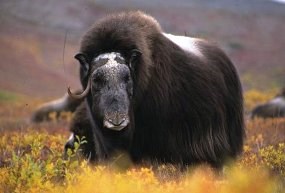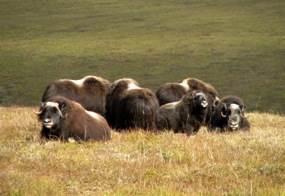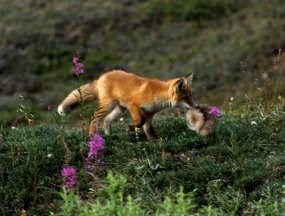|
Muskox | Designed for the Arctic | Food and Family | Circle Defense | 
Claudia Ihl The Incredible Journey By about 1900, Alaska's muskoxen had been completely wiped out. Over hunting certainly played a role in the demise of Alaska's muskoxen, but recent DNA studies suggest that unfavorable climatic conditions may have also been a factor in the decline of populations since the Pleistocene In 1930, the United States Congress allocated funds to reintroduce muskoxen to Alaska with the goal to domesticate the animals and find profitable ways to use them. Thirty-four muskoxen were captured by Norwegian sailors in Greenland and transported by ship back to Norway. Then they were taken by steamship across the Atlantic Ocean to New York. After a month in quarantine, the small herd of muskoxen traveled by train across the United States to Seattle, where they were loaded onto another steamship bound for Seward, Alaska. Next, they were back on the rails from Seward to Fairbanks on the Alaska Railroad. Now 8,000 miles from their original home, the herd was kept in a forest clearing near Fairbanks for the next five years. 
Richard Nelson In 1935 and 1936, the muskoxen were taken down the Yukon River by steamship and loaded onto a barge at the Yukon River mouth. The barge nearly sank in a Bering Sea storm, but was kept afloat by men working hand pumps. At last, the animals reached their final destination on tundra-covered Nunivak Island in the Bering Sea, off the Alaska Coast. Over the following decades they thrived and multiplied, and today there are about 600 muskoxen on the island. Muskox hunting provides food for Yup’ik villagers on Nunivak, and it is also a source of income from outsiders who come to hunt muskoxen on native lands. Between the 1960’s and 1980’s, muskoxen were transplanted from Nunivak to nearby Nelson Island, the Arctic National Wildlife Refuge, the Seward Peninsula (Nome area), and to Cape Kruzenstern near Kotzebue; and some were also transplanted to Russia. Who would ever guess, watching these muskoxen peacefully grazing, that their ancestors came from far away Greenland—traveling 8,000 miles by steamship, train and barge? 
Claudia Ihl Domestication What happened to the original plan to domesticate muskoxen? Domestication projects were first begun at Unalakleet in arctic Alaska and Fort Chimo in Northern Quebec. The Fort Chimo animals were later released and their descendents are now living free. Alaska’s domesticated herd was eventually relocated to Palmer, near Anchorage, where about a hundred muskoxen are raised specifically for qiviut—the underfur—sometimes called the rarest fiber in the world. It is used to make exquisitely soft, warm, and beautiful clothing. A small herd also remains at the original “muskox farm” near the University of Alaska in Fairbanks. Both captive and wild muskoxen are a big draw for tourists and photographers visiting Alaska. Muskox | Designed for the Arctic | Food and Family | Circle Defense | |
Last updated: December 16, 2020
